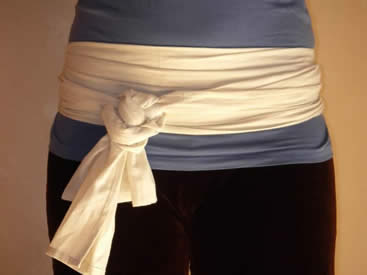HOW TO MAKE AND USE A FAJA

The faja can be made from items found around any house if need be but it is better to establish for yourself a certain kind of womb/sacral band that you can make and feel comfortable using. In Central America, women bring their own faja when they come for a treatment. They know they may need some extra help after the womb massage.
You will need a strip of cotton cloth (about 12 inches wide) that is sufficiently long enough to wrap around the pelvis twice with enough left over to tie a knot or tuck in the ends. An Ace Bandage works very well, but caution must be used because it is easy to make the band too tight. A piece of an old cotton sheet or a shawl works well too.
Next, you will need is a bunched up piece of cotton such as a sock, a handkerchief, or even a dishcloth. This item should be balled up and placed in the location where the womb may have been leaning, in order to encourage it to release the the tension so she can freely move.
Place the long piece of cloth loosely under your back, so that it's ready to wrap around your body. Then place the balled up cloth if needed after determining the need while massaging the womb. Then start wrapping the faja around the pelvis and over the ball of cloth, tight enough to hold the ball of cloth in place, but not tight enough to cause a circulation problem.
file:///C:/Users/djcai/Downloads/ATC-Faja-A4.pdf
Make sure the faja is snug, not too loose or too tight. If it is too tight, your legs may feel tingly or numb or start turning blue. In that case, loosen the band to allow for proper blood flow up and down the pelvic area. Wearing the faja will allow the body time to repair the womb/sacral ligaments until they are strong enough again to hold the organ place; it will also allow for proper drainage of veins and lymph nodes to eliminate accumulated toxemia in these areas.
The faja is worn in place for as long as it takes to heal the ligaments with the now normalized blood supply and nerve impulses. This can take anywhere from 24 hours to 30 days. It can be worn all day long while moving, but not while sitting. It is best to wear under the panties so you can easily eliminate when needed..
THE FAJA SHOULD NOT BE WORN AT NIGHT OR DURING MENSTRUATION!
Best not to wear high heel shoes more than an inch high, avoid running, high impact exercise classes, lift heavy objects, ride horses, etc. during this healing period while wearing the faja. Continuous jumping or running on hard surfaces will cause the ligaments to over stretch again and will be counterproductive to healing.
Many clients report that the faja is extremely comforting and gives them a feeling of renewed strength and energy. Usually, a woman knows when she no longer needs to wear a faja. Sometimes, especially in younger women who have had no pregnancies, it can truly take only 24 hours to repair the over stretched ligaments. The healing may take as long as a month in severe, complicated cases with multiple symptoms or a history of multiple pregnancies with difficult deliveries.
Be patient! The massage and faja ALWAYS help. Some of my clients choose to wear the faja for a day or two before their menses begins to alleviate that feeling of heaviness. Then that, too, becomes unnecessary. Others just wear it because they like the way it makes them feel.
